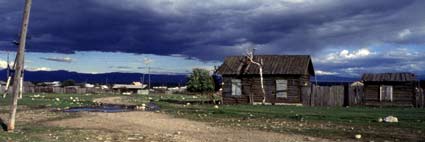The Tribe of Kurykans

Not much is known about the Kurykans, and that's probably the reason why their culture is that much shrouded in legend. We only know that a nomadic tribe (presumably a Turk tribe) lived close to Lake Baikal or on Olkhon Island respectively some time between the 6th and 11th century. Only when the Mongolians started their conquests under Chingis-Khan, the tribes were forced to move farther north, so that later on the area would be settled by Buryats.

On Olkhon Island alone, more than 100 finds or relicts attest to the colonization of the Kurykans. The most impressive remnants can be found at Khargoy Cape in the southern part of the island. A still clearly visible dry stone wall, which separates the whole bay from the rest of the island, is most striking. Until today, the function of this wall has still not been explained. Not far from it, a number of old tombstones as well as the remains of several houses can be found. At the center of the formerly biggest house, several cooking and conservation utensils have been found, which presumably implies that this must have been the location of the villages central cooking facility.

Otherwise, a number of stories are circulating about the culture of the Kurykans as well as about more finds, such as, for example, a sacrifice stone near a steep cliff not far from the Kurykan wall. You can find a loose interpretation attempt, which is amusing to read, on the pages of Klaus Heid. There, he is describing the "results" of his 1995 Khuza expedition.










